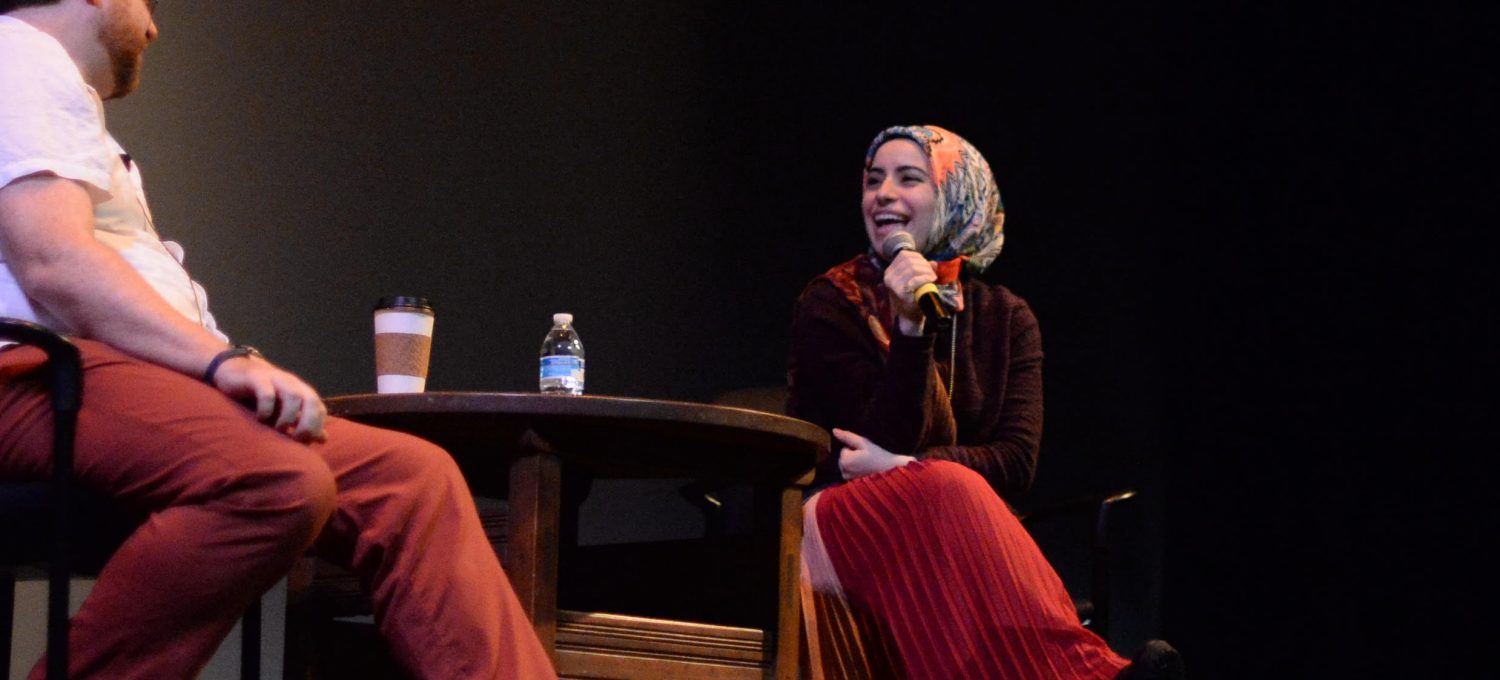On the final day of the Movies and Meaning Festival this past weekend, festival director Gareth Higgins sat down for a conversation with Muslim artist and activist Mona Haydar. Read on for more of her thoughts on faith and art and their power to see us through into the future.
Earlier this year, in a post-screening Q and A, Tarrell Alvin McCraney, the playwright and screenwriter of Moonlight, talked about how a drug dealer taught him to ride a bike. Part of his motivation for writing Moonlight was an attempt to capture that life before it disappeared from his memory and to show the world that “people like this exist.”
Listening to Mona Haydar speak about her journey and work brought McCraney’s story to mind. She’s emblematic of members of those invisible–or ignored–communities, which makes her recent music video all the more important. The video for her rap song, “Hijabi,” embedded below, has over two million views. It’s full of swagger and joy and is a celebration of Muslim women from Muslim women, which makes the criticisms of it even more telling. Haydar joked, “I’ve brought the alt-right together with far right Muslims. It’s wildly entertaining to me.” On one hand, conservative Muslims claimed she isn’t actually a Muslim, and, on the other, members of the alt-right argued that she’s a Muslim fundamentalist snearing Sharia law into American culture. After only a few seconds of hearing her speak, you know–and feel–that both claims are equally absurd.
But Haydar is not simply “hiding” behind a YouTube video. She’s also put herself in potentially violent situations. After the terrorist attacks in Paris and San Bernardino, she and her husband put up a booth, like Lucy in The Peanuts, where they offered coffee and donuts to their neighbors to create space for conversation. Those encounters were spiritually transformative for her, but not necessarily for everyone that participated. Some people walked away in anger and hatred, fueled by a more popular narrative.
I recently heard comedian Gibran Saleem introduce himself as “a Muslim, you know, like from the news.” Haydar doesn’t fit this Muslim stereotype, because, as she says, the media deals in division and war, and “Islamophobia is a capitalist enterprise.” Through her music, poetry, and speaking, Haydar is breaking through those stereotypes, showing us real people, not abstractions, who often go unseen in film and pop culture. Consider her identities: a Muslim American woman from Flint, Michigan; married with two young boys; currently attending Union Theological Seminary in New York; a poet, rapper, and MC, who counts among her friends Tunde Olaniran, the brilliant musician who produced her “Hijabi” video. In all cases, she’s looking to, as she joked, “kick ass…theologically.”
Haydar jokes about kicking metaphorical ass while also preaching a message of love, peace, and justice, drawing inspiration from the prophets Muhammad and Jesus (with whom she admits to having a passionate love affair) and the teachings of the Buddha. She refers to the prophets as “the pinnacle of possibility,” and adds, “I’m Muslim because I believe in all of them. It’s wildly inclusive. That makes many people uncomfortable.”
Equally uncomfortable is her dichotomous experience as an American citizen, specifically the tension between being critical of current domestic and foreign policies and practices, while remaining grateful for the opportunities that being born in this country has afforded her. A chief concern for her is our tendency towards violence and the military industrial complex. Haydar laments, “A portion of our taxes go to the defense fund. Work that we do–that can be meaningful for us–results in death around the world. This is not abstract.”
But to listen to Haydar speak is to feel hope. It may sound more naive than ever, but the message has never been more necessary for Haydar and those of us who share in this belief: art can save the world. And for our conservative neighbors, she offers this encouragement: “Artists are cheaper than bombs.” Both art and faith allow us to, as Haydar raps, “teleport through trauma.” She pushes back against the popular opinion that faith and religion are ultimately divisive and oppressive. Instead, she sees them as part of ancient and modern technologies that help us heal from and live with our woundedness. The greatest threat to both art and faith, however, is fear, another tool of capitalism. As Haydar and her husband prepared for their coffee and donuts conversations, they were nearly paralyzed by fear: “We knew that people in pain can combust and lash out. We couldn’t allow that fear to stop us.”
So how do we respond? First, we don’t take anything personally, because, as Haydar points out, most people’s anger has more to do with them than it does the object of their anger. She also offers a vision for how to address the fear that persists: “We sit so deeply in it [the fear] that it becomes our friend. […] The end result of moving through fear into trust [in the power of engagement] is always the creation of more love in the world.” To hear Haydar speak and see her in action is to know that this love is real, not abstract.
To learn more about Mona Haydar and her work, visit: monayahdar.com
To subscribe to the work of Movies & Meaning, visit: theporchmagazine.com
